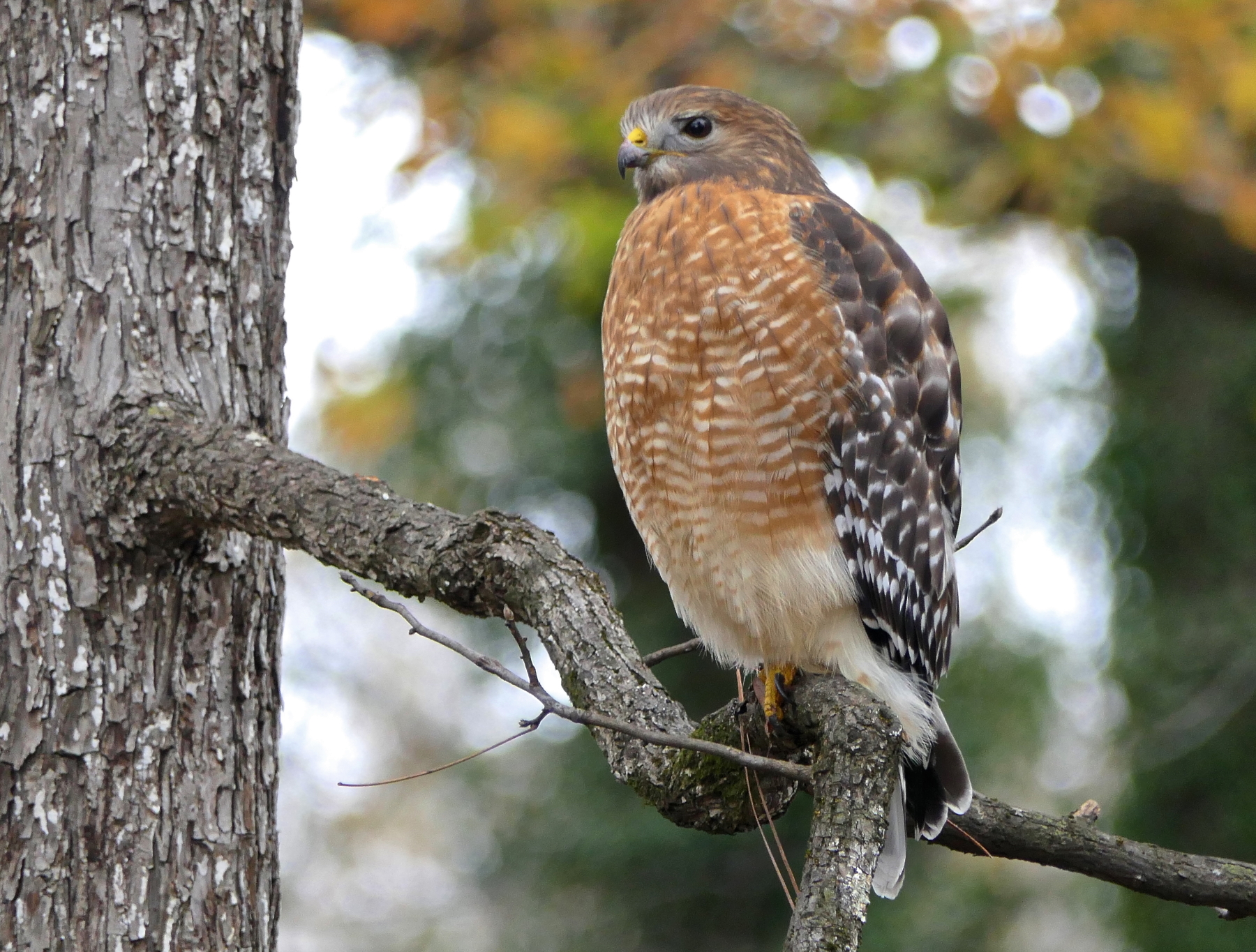
Red-shouldered Hawk (Linda May)
By Terry W. Johnson
We have all have heard a murder of crows loudly cawing near our homes. When we do, we realize that, in many cases, the crows’ incessant, agitated calling can mean that a predator is close by.
But when we find that American crows are targeting a red-shouldered hawk perched on the limb of a tree near our home, is it reasonable to fear for the safety of our pets or the birds visiting our feeders?
Good question.
Let’s start with the fact that red-shouldered hawks are year-round residents throughout Georgia. You’re likely to see one of these avian predators at any time. Although red-shouldered hawks do not migrate, because the species breeds in states far north of Georgia and migrate to our state and points south, the chance of seeing them during the winter is greater than at any other time of the year.
Red-shouldered hawks prefer to nest in mature bottomland forests and near lakes and rivers. With the expansion of urban and suburban areas over the past several decades, the birds are more frequently nesting in these areas, too.
Especially during the winter months, red-shouldered hawks often hunt from perches on utility wires strung along open fields and highways. In fact, if you spot a medium-sized hawk on a utility wire, more than likely it will be a red-shouldered hawk. These raptors prefer to hunt from such elevated perches. When they spot a small animal, they drop down and attempt to snag their prey with sharp talons before it can escape into thick cover.
Red-shouldered hawks are opportunistic hunters, which is just a fancy way of saying they will eat just about anything they can catch. Several years ago, a homeowner told me that a red-shouldered hawk was wading into a shallow artificial pond in his backyard to nab goldfish. The hawks also dine on earthworms, large flying insects, frogs and snakes. In one instance, a red-shouldered hawk attacked a garden hose. I’m sure it mistook the hose for a snake. A fellow Georgian even reported watching a red-shouldered hawk devouring crow eggs.
But the favored prey of these medium-sized hawks (they weighs only 1.1-1.9 pounds) are chipmunks and voles. Red-shouldered hawks will, of course, consume other small mammals such as mice and hispid cotton rats. When food is scarce, they will also hunt larger prey, but no larger than rabbits and gray squirrels. I was recently sent a photo of a red-shouldered hawk flying close to the pavement along a road in a subdivision. The man who took the picture said the hawk seemed to be laboring to gain altitude as it made off with its prey – a gray squirrel.
From time to time, red-shouldered hawks will also eat birds. The birds most often captured at feeders are European starlings, house sparrows and mourning doves. A study conducted in Georgia found that away from feeders, red-shouldered hawks will on occasion capture other species, including indigo buntings, American robins, common yellowthroats, northern cardinals, Carolina wrens and pine, hooded and Kentucky warblers.
One reason why red-shouldered hawks do not eat more birds is that the hawks’ relatively broad wings and short tails make it difficult for them to maneuver quickly enough to capture small birds.
The red-shouldered hawk does not have a big appetite. Food habit studies suggest they eat 11 percent of their body weight in food daily. This is roughly the equivalent to two to three small rodents.
The thing we should keep in mind is this bird of prey typically does not attempt to catch and eat anything larger than a rabbit or gray squirrel. Consequently, if our cats and dogs are no larger than either of these animals, they should be safe from harm.
Everyone who feeds birds realizes that hawks are attracted to concentrations of birds found around our feeders. However, because of the size of red-shouldered hawks and the fact they often become quite comfortable in urban and suburban settings, we see them more often than other hawks. Therefore, they are often wrongly blamed for hawk attacks on backyard birds. Yet in the vast majority of such cases, the culprits are much smaller hawks such as sharp-shinned and Cooper’s hawks.
Even then, the number of feeder birds lost to hawks is minimal. This is illustrated by an analysis of FeederWatcher survey data conducted by Cornell University and others which revealed that “most FeederWatchers who witnessed predation (by hawks) saw one or two cases over the whole winter.”
I hope this information will allow to you utter a sigh of relief when you see a handsome red-shouldered hawk in your neighborhood. These encounters are something far too few Georgians ever had the opportunity to enjoy.
Terry W. Johnson is a retired Nongame program manager with the Wildlife Resources Division and executive director of The Environmental Resources Network, or TERN, friends group of the division’s Nongame Conservation Section. (Permission is required to reprint this column.) Learn more about TERN, see previous “Out My Backdoor” columns, read Terry’s Backyard Wildlife Connection blog and check out his latest book, “A Journey of Discovery: Monroe County Outdoors.”




















